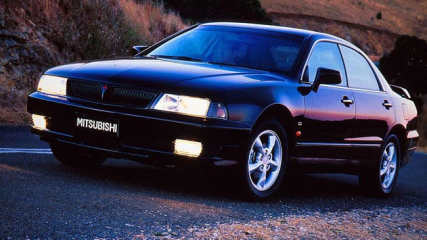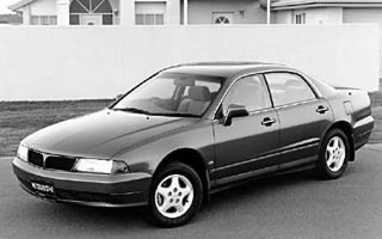Used Mitsubishi Magna review: 1996-1997
By Graham Smith · 29 Jan 2009
What is it about the Magna that fails to win over the hearts and minds of the car buying public? Sure the first generation, the TM through TP, came close to being the last when it developed a series of very public problems in service, but the second generation, the TR and TS, also failed to score despite being a very good car.Problem was that it was perceived as boring, the sort of car your grandfather bought to see out his dotage. Bowling club car parks were filled to overflowing with them, hats resting on the rear parcel shelf, their drivers dressed in beige cardigans. Simply, they weren’t cool.By rights that should have changed with the release of the TE model in 1996. It was an attractive car with clean elegant lines that were a huge leap from the plump and portly middle-aged curves of its predecessor. But things didn’t change, it too was stuck with the same image of a middle of the road car for the elderly. Pity because the TE Magna, and its successors are very competent cars and well worth a second look on the used market.MODEL WATCHAlongside its predecessor you could have been forgiven for not recognising the TE as a Magna, so complete was the transformation. With a lack of door window frames and a slim centre pillar it had the appearance of a stylish pillarless coupe rather than a functional family four-door.The TE was longer and wider than the TS and that meant there was a little more leg room for both front and rear seat passengers, but the sweeping roofline, as attractive as it was, came at a price in terms of head room. It affected both front and rear seat passengers, but was more of a problem for anyone seated in the back.It was all new inside as well, although it was a little dark and sombre with a combination of grey trim and a high waistline that cut down the light from outside.The Magna was born a four banger, but over time grew into a six worker, and the TE continued that trend with even greater emphasis on the six-cylinder models.The range initially comprised of two models, the Executive and Altera, both of which offered the choice of four and V6 engines, and four-speed auto and five-speed manual transmissions. From October 1996 fully equipped Advance and Altera LS models were added to the range.The four was a new 2.4-litre fuel-injected unit which despite being smaller than the engine it replaced, with 105 kW and 205 Nm it was more powerful as well as being noticeably smoother. Compared to the previous model performance was improved when fitted with the auto trans, and about the same with the manual.The fuel-injected 3.0-litre V6 was also all new with increased power over the engine it replaced. Boasting 140 kW and 255 Nm it was markedly quicker than the old model to the 100 km/h benchmark, as well as boasting improved acceleration in the crucial 80-100 km/h overtaking region. Importantly the increased performance didn’t come at the cost of fuel consumption.A four-speed electronic auto was new, and boasted the ability to adapt to the driver’s pattern of use and road conditions to select the optimum gear for any situation.Suspension was independent front and rear, along with disc brakes, and there was an option of an ABS antilock braking system.Entry to the TE range was via the Executive which featured power steering, four-speaker sound, power mirrors, tilt-adjust column, remote boot and fuel filler release, central locking and engine immobiliser.For all the bells and whistles look for an Altera, which came standard with air-con, power windows and cruise.Options included airbags for driver and passenger, ABS, CD player and alloy wheels.The Advance and Altera LS delivered the lot, with ABS, airbags, CD and alloys standard fare.On the road the TE was smooth and refined with a comfortable ride and nice chassis balance and plenty of punch when pushed along a winding country road.IN THE SHOPThe trade reports the Magna as generally robust and reliable. Even though they are now climbing in mileage they still make a great second car for the family, or a first car for the novice driver.Both the four and six-cylinder engines give little trouble, particularly the six. The fours can have problems with water pumps, and there can be oil leaks from the cam cover. The 2.4-litre four-cylinder and the six-cylinders have timing belts, which requires replacing at 100,000 km intervals. Both give little trouble in the driveline area so there’s little reason for concern over transmissions.Tyre wear is generally good, with more than 50,000 km regularly reported depending on the tyres fitted. Brake wear can be a problem with rear pads requiring replacement around 30,000 km on average. Front brakes are bullet-proof with front pads lasting “forever” according to one mechanic. Discs are also long wearing.OWNERS SAYFord fan John Hansen was first given a Magna as a company car, but any doubts he had about it quickly evaporated during the two years and 150,000 fault-free kilometres he drove in it. A second Magna has been equally as impressive. “The first Magna came with the job, but from then on it was performance, reliability and comfort that kept me in them,” he says. He adds that tyre life, at 60,000 km, is particularly impressive.Country readers Alexander Smith and his wife are equally enamoured with their two 3.0-litre V6 Magnas. One, a sedan, has done 70,000 km without fault. Apart from scheduled servicing the only things he has had to replace are the tyres, which were replaced at 42,000 km. The other, a wagon, has regularly towed heavily laden trailers and a caravan in the 100,000 km it has done, and has been just as reliable as the sedan. A battery and a tail light globe are the only things that have needed replacing, along with a set of tyres at 41,000 km.LOOK FOR• Robust and reliable engines and trans.• quiet and comfortable interior• smooth elegant styling• restricted rear headroom• balanced handling• beaut performance









